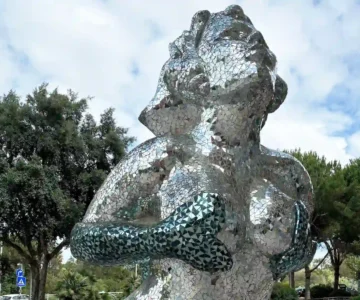This is Part 5 of a nine-part series where I document what happens when I dive headfirst into Bibi Brzozka’s Waves of Pleasure program on Mindvalley. Forget the orgasm (for now). Start with a mirror.
Have you ever met your pussy?
I know, I know. What kind of question is that, Tatiana?
But it’s a legit one. Have you?
Not as in shake-your-hand-hi-I’m-so-and-so (plus, the sheer logistics of bending over and actually coming face-to-vagina is categorically hysterical). But as in having a look and actually getting to know her highness other than through some sort of sexual act.
That’s the entire basis of Day 5: getting to know your pussy. It shouldn’t have come as a surprise, though, considering we had already covered other erogenous zones. (If you have no idea what I’m talking about, you can backtrack to Part 4 and catch up.)
But when Bibi Brzozka said, “I want you to pause and think about your relationship to your pussy,” the immature me couldn’t help but giggle like Joey Tribbiani losing it at “homo erectus.”
That’s the thing, though. If just saying the word sparks a juvenile fit of laughter, what does that say about everything we’ve been taught to feel?
Our pussies are often degraded or deemed taboo… And guess what? We internalize that.
— Bibi Brzozka
The problem with pussy
So few of us are pussy positive, as Bibi highlights in her Waves of Pleasure program on Mindvalley.
That’s not saying we’re against pussies. Far from it. It’s just that when we hear the word, so many of us tend to get all 50 shades of red.
Not only “pussy,” but every other cute name for the vagina. Caitlin Moran wrote a piece, “Honeypot, Flaps, Twat: Nicknaming a Vagina Is Tricky Business” (which unfortunately is no longer available on the Internet), that dissects this very topic.
“No one I know would refer to their vagina as their ‘vagina,’” she writes. “They have slang names, pet names, made-up names — family names for the front parlor that have been passed down from generation to generation.”
…And society agrees, it seems. In a 2019 survey of 3,670 readers, Refinery29 found that while about half stuck with “vagina,” the rest rolled deep in euphemisms: “pum pum,” “lulu,” “muffin,” and “hoohoo.”
I, myself, was taught to call my womanhood “pepet.” This is considered vulgar in Bahasa Malaysia. And even in school, it was often referred to as “kemaluan,” which roughly translates to “the area of shyness.”
It’s no accident that so many of our words for the vulva are either cutesy or shame-soaked. “The word ‘pussy’ is thrown around as an insult or derogatory term,” says Bibi. “And guess what? We internalize that.”
It’s a fact that 90% of women feel insecure about their bodies. On top of that, 25 % of women say they feel uncomfortable even bringing up vagina-related issues with healthcare professionals. And when symptoms do show up, more than a third wait over a year or never speak to anyone at all.
Which is why Bibi, like so many others in the conscious sexuality space, uses the word yoni.
Wait, what is a yoni?
I’m about to get a bit technical here. But if you’re anything like me (40+ years old when I learned what yoni meant), knowing the context can help truly understand why it’s so much more powerful to use than “pussy.”
You see, yoni is a Sanskrit word that means “source,” “womb,” or “sacred space.” It refers to the entire female reproductive system, including the vulva, vagina, and uterus.
In Hinduism, it represents the creative power of women and is often connected to the goddess Shakti. You’ll sometimes see it shown with a symbol called the lingam, which is a symbol of the masculine. Together, they show the balance of masculine and feminine energies.
More than just a word for the female body, yoni is honored as a powerful symbol of feminine energy. And in many spiritual traditions, it’s treated with deep respect as the place where life begins.
In some places, this reverence takes physical form. As in, it’s built into the architecture.
The late Psalm Isadora, a tantra healing expert, got to experience going to a temple in India. “When you walked in,” she shares in her Mindvalley program, Tantra Touch, “the center of the temple was considered to be a yoni, or that sort of great vagina, where all the sexual energy comes from.”
She teaches to approach another person’s body with that same sense of awe. Kind of like, “I’m coming to the temple and worshiping your most sacred place there with that devotion, and giving that energy, and finding pleasure in watching every movement of your partner’s body as they receive pleasure.”
(Ahhh…this is probably why Bibi calls this lesson “Yoni Temple Rituals”!)
And that brings us back to the question: have you ever met your puss…yoni? I sure have NOT.
What now, yoni-cat?
So“pussy” turns me into a Joey Tribbiani at a paleontology conference.
But the reality is, a woman’s perception of her genitals can influence her sexual health. Research shows that a positive genital self-image is associated with better sexual function, including increased desire and satisfaction.
Which tells me this isn’t just about vocabulary. It’s about access to pleasure.
“When you begin to honor and cherish your pussy and your body as a whole, you can learn to embrace deep pleasure,” says Bibi.
But the question is, where do I even begin? Luckily, she has a few ideas.
1. “Take a mirror and have a proper look at your vulva.”
I can’t say that I’ve ever done so. Even when I was diagnosed with cervical cancer, I didn’t want to dwell on the region. A kind of “ignorance is bliss” attitude.
But I want to have a better relationship with my yoni. So okay, Bibi, let me see how I feel about her.
I looked, blinked, tilted the mirror like I was inspecting rare artwork… And honestly? I didn’t hate what I saw. And, as cliché as it sounds, she was beautiful.
2. “Use your conscious erotic touch.”
This means “moving away from the goal of sexual arousal and focusing instead on discovering and perceiving sensations and pleasure moment to moment.”
As with what I learned with the lesson on breast massage, I can say I’ve never thought (or been taught) to be in the moment. Or even to be mindful of how touch feels in general.
Is it gentle? Is it rough? Do I like it?
But in doing this part of the ritual, I… understood the assignment.
3. “Know [your] genitals through a conversation with them.”
With my diagnosis, I decided to call the cancer “Felicia” so that when I’d finally be clear of it, I could say, “Bye Felicia!” (You Friday fans know what I’m talking about.)
But when Bibi said, “The first step in connecting with your yoni is to give her a name,” I thought, should I call her “Craig”? 😂
In all seriousness, no name came up. Nothing that felt…right. Like it belonged to her.
Why was it almost instinctive when it came to Felicia or to Punch (my car)? But when it comes to my “sacred space,” this “magical” and “erotic” source of pleasure?
Blank. Space.
Do you think it could be because I spent some 40-odd years without a connection to her? Or maybe I just didn’t know I was allowed to?
That could also explain why I found it kind of hilarious that Bibi presented the yoni meet-and-greet as: see you, feel you, then get to know you.
It’s basically the opposite of how I usually approach connection. I like to talk to someone before I touch them.
And all of this made me wonder: if I’ve gone this long without knowing how to meet her, how many of us have been doing the same?




